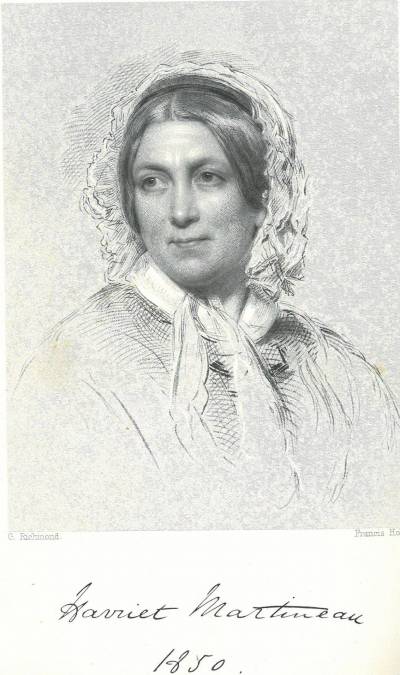 Harriet Martineau (1802–1876) was an important activist with regard to her long-running campaign for the abolition of slavery in the United States. However, she also occupies an important place in the development of sociology, political economy and women’s rights; she achieved fame as well as an early female journalist. Above all, the skill of Harriet Martineau lies in her ability to write clearly across a range of genres and to bring to readers a new approach to analysing the functioning of societies.
Harriet Martineau (1802–1876) was an important activist with regard to her long-running campaign for the abolition of slavery in the United States. However, she also occupies an important place in the development of sociology, political economy and women’s rights; she achieved fame as well as an early female journalist. Above all, the skill of Harriet Martineau lies in her ability to write clearly across a range of genres and to bring to readers a new approach to analysing the functioning of societies.
Her early religious writings reflected her Unitarian upbringing but she was soon writing more widely for a number of periodicals. Her first important work was Illustrations of political economy in 1832 which was the collection of a series of articles explaining the works of Adam Smith and the operation of a market economy. These included a portrait entitled A Manchester strike, a tale written in 1833.
She also helped to explain (and popularise) the work of Mill, Bentham and Malthus.
Having achieved some financial success through her work she spent two years in touring the United States. She realised that slavery was quietly favoured by most of the population and especially by most, but not all, religious groups. She observed that women, although themselves slaves of the system, were also at the forefront of the anti-slavery movement and she looked at the operation of the Female Anti-Slavery Society in Boston and similar groups across the country. In support of abolitionism she and other supporters were often placed in grave danger given the widespread violence inflicted upon them.
Whilst The martyr age of the United States dealt with the abolitionist movement two other works – Society in America (1837) and How to observe morals and manners (1839) – are important in that they demonstrate her view that in order to study society it is necessary to study all of its component parts. From this analysis it is possible to understand inequality, slavery, moral behaviour and discrimination against women.
She also translated into English the works of August Comte in 1853, thus introducing into Britain one of the foundation texts of sociology. She maintained her commitment to anti-slavery work by writing articles for journals both here and in the United States for most of her life. She also wrote novels and short stories inspired by her visit to the United States including The hour and the man which featured the leader of the Haitian slave rebellion Toussaint L’ Ouverture.
From 1839 Harriet became seriously ill and she bought a house and hired a companion to manage her illness over a period of years. During this time she wrote Life in the sickroom: essays by an invalid which was an important text because it was based on the ‘invalid’ assuming control over the sickroom and the management of her own illness. Such a position was clearly opposed by men in the medical profession, but is considered a landmark in reflective women’s writing.
In 1844 she underwent a course of treatment by mesmerism (nearest modern equivalent being hypnosis) and when recovered moved to the Lake District and then travelled extensively in the Middle East. This visit resulted in her rejection of organised religion and the writing of Eastern life, present and past in 1848.
From her base in Ambleside Harriet wrote guide books, histories and a range of works on women’s education and atheism. She continued to write for a broad range of publications and campaigned on a number of issues affecting women, principally that of female suffrage.
When Harriet started to suffer from heart disease in 1855 she began to write her autobiography in anticipation of imminent death. In addition to her coverage of the many episodes in her life the autobiography contains details of her experiences in the United States, meetings with many notable Victorian figures, her views on the position of women and how she dealt with her profound deafness.
The Working Class Movement Library has a range of works to come in and read in order to assess the life of an important female activist and thinker. These include her Autobiography [Shelfmark B12] and Biographical sketches [B18] and her history work: The history of England during the thirty years' peace 1816–1846 [D61 – two volumes].
In addition, the Library has a collection of her writings on the Poor Laws, Poor laws and paupers illustrated [D05] and Illustrations of political economy [D05] on the Manchester Strike.
Works about the life of Harriet include works entitled Harriet Martineau by Florence Fenwick Miller [B12], John Cranstoun Nevill [A13], and Harriet Martineau: a radical Victorian by R.K. Webb [S20]. Works which examine the many aspects of her life include those by Shelagh Hunter [Q50], E.A. Pratt [A11] and Dale Spender [X28].
